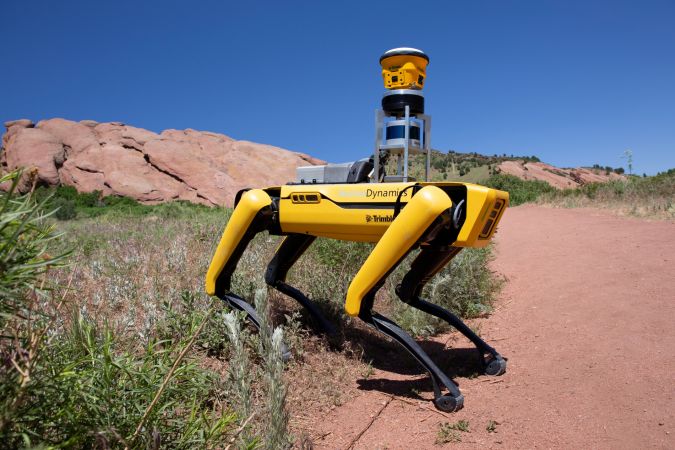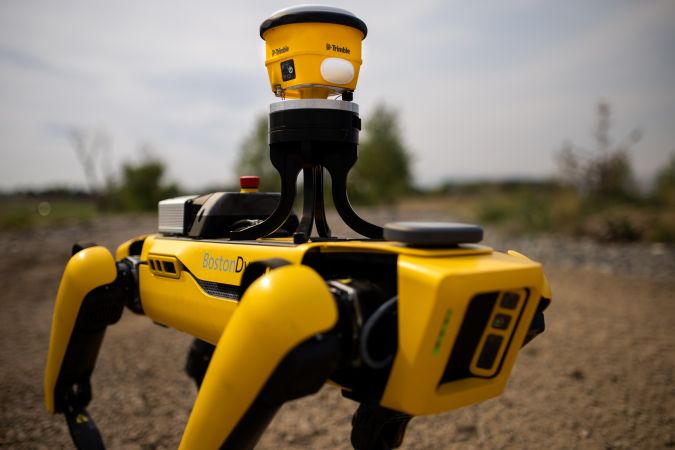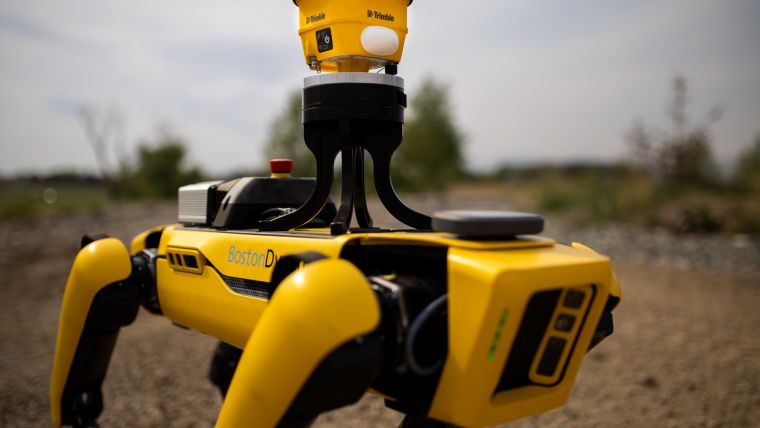Integrating robotics into the construction surveyor’s workflow
Robots equipped with laser scanning, total station and GNSS technologies
How are robots and autonomous technology likely to affect surveying roles as they become increasingly integrated into workflows?
With great possibilities come great responsibilities, and this is particularly true for the role robotics and autonomous technology can play in our world. Over the course of time, technological possibilities have drastically changed the face of many jobs in surveying, construction and geospatial applications. Since the 1990s, for example, robotic total stations have resulted in an enormous leap in productivity by making it possible for an operator to carry out a site survey alone thanks to automated rotation and tracking of the prism. With robotics and autonomy becoming increasingly pervasive, combined with disruptive developments like the Internet of Things (IoT), 5G, big data and machine learning, this article explores how other roles are likely to change too as robots become more integrated into workflows, such as for data collection.
As the technology inside the systems has miniaturized, it has become increasingly possible to automate and robotize relatively simple tasks such as setting up a total station or scanner. For instance, some robotic total stations and scanners can now self-level and auto-calibrate, eliminating human intervention from yet more tasks that are best left to technology. However, automating workflows is a different matter entirely. Firstly, the robots will need to be much more intelligent than the ones that are currently being deployed in construction. Secondly, the use of robots that have an increasingly higher level of autonomy will change the face of the workflows themselves.
Strategic alliance
Its strategic alliance with Boston Dynamics gives Trimble the opportunity to offer the construction sector an integrated robot solution that has the ability to redefine workflows. Within their partnership, which started last year, the two companies are working to co-develop and sell an integrated solution that is able to complete a construction-surveying or as-built reality-capture workflow, for instance, with a high degree of autonomy.
Send in the robot
The solution is based around the Boston Dynamics Spot: a four-legged mobile robot specifically designed to navigate difficult terrain. Having legs instead of wheels – unlike robots that are already working in warehouses or production facilities – is a huge advantage in the case of uneven surfaces, stairs or operating in the dirt. Spot has therefore proven to be a great tool for hazardous environments in excavation or building construction, but also for applications in mining, oil & gas, utilities and other sectors that have projects requiring a high level of risk mitigation. The robot can also be deployed in places where entry to the site requires an often lengthy permit procedure – even for the simplest of tasks – for humans, but not for tools. The robot is not totally autonomous as it is remote-controlled using a tablet (and stereo cameras). However, it has a number of near-autonomous capabilities, such as its self-righting ability. Moreover, since repeatable autonomous missions can be programmed, its 90-minute battery life is the only real limitation to having Spot put in a day’s work all by itself – and work is currently underway to develop a charging dock that the robot automatically returns to as a way of tackling that issue.

Conscious technology
Thanks to its payload capacity of up to 14kg, the Spot platform offers the promise of total autonomy, as additional technology can make it more ‘conscious’ of its environment. A 3D scanner and/or a GNSS module would give Spot the terrain-agnostic capabilities needed in a typically dynamic setting of a construction site by enabling it to navigate obstacles in order to fulfil its programmed task. Construction companies are already applying a number of Spot robots in such a configuration to work in places that are difficult to access or navigate, such as airfields and live construction sites. In these cases, there is direct communication with a cloud-based construction management application so the mobile technology can feed back information to the construction environment.
The robot can be equipped with a Trimble 3D scanner for use in routine tasks such as daily site scans (which can even be done at night), progress monitoring, asset management and remote support. In fact, one of the main drivers behind Boston Dynamics’ go-to-market strategy for Spot was the realization that much of the construction sector still suffers from a data gap and is in need of technology to increase site efficiency. With data collection being one of the most needed but least loved tasks among construction surveyors, Spot will now be able to provide consistent output, deliver improved efficiency on repeatable tasks and enable up-to-date as-built data analysis which helps to reduce the amount of rework and facilitates on-site tasks. The goal for the near future is to further enhance field-oriented workflows by integrating the data collection workflows with the workflows needed to operate the robot.
Repeatable approach
This turnkey solution will streamline the operation of the robot and provide quality control for missions. With robots scanning the site at night and delivering images for the supervisor to check in the morning, it will be easier for construction project managers to get a clear picture of job-site progress on an ongoing basis. Mortenson, a contractor, developer and engineering services provider headquartered in Minneapolis, USA, is one of the first customers to use this technology combination. In an effort to eliminate job-site waste and to increase efficiency, the team has been piloting Spot robots with Trimble’s SPS986 GNSS Smart Antenna to autonomously navigate challenging exterior construction environments, including a solar farm to continuously document existing site conditions. This automated and repeatable approach to field-data capture can provide Mortenson with real-time awareness of project status, helping to accelerate project delivery.
Operational integration
Equipping the Spot robot with third-party tools (such as scanners, GNSS modules or other tools) for a certain task is a true milestone, since it is a step up from purpose-built single-task robots that have been used for activities such as construction site layout so far. The next challenge that the Boston Dynamics/Trimble alliance is now undertaking is to integrate the two technologies to enable them to be managed and operated as a unit. Other challenges on a larger scale include the challenge around IoT. Due to the rising number of sensors that are being deployed and the further deepening and granularity of techniques such as BIM, robotics must be integrated into the broader ecosystem. This requires the trusted exchange of data from the robot with a rapidly evolving and exponentially growing cloud. Access to more information will increase the robot’s situational awareness, enabling it to better understand its environment and the changes that happen within its surroundings. On a more low-tech level, introducing robots into the workflow brings with it complications such as how to manage a fleet of these novel devices, how to run maintenance schemes without interrupting workflows – in other words, how to truly integrate robots into operations. All these items require existing workflows to be revisited.

Extra intelligence
Research by McKinsey from a couple of years ago suggests that it is more logical to consider both robotics and autonomy based on machine learning in terms of their impact on work activities rather than on occupations. As was the case in the previous industrialization waves, the fourth wave we are witnessing now will not cause many jobs to totally disappear in the short term, but will have a direct impact on processes and workflows, thus changing the nature of people’s jobs.
For the wider surveying community this means that even more focus will shift towards tasks that require human insights and that cannot yet be captured in algorithms. Technology developments in systems like rovers, scanners and total stations and networks like GNSS and RTK have already been the technology enablers, making the work more efficient with more reliable results. New technologies like tilt compensation have further widened the spectrum of possibilities to deliver high-quality results under difficult circumstances. All in all, these advancements have put a lot of extra intelligence in the hands of the surveyors – the intelligence that is needed to make human assertions and decisions on the big issues: how and where to build with minimal impact within the rapidly urbanizing environment, or how to maintain stringent data quality in a developing IoT environment. Those are the types of questions that will be on surveyors’ minds for years to come. But as for the dull, dangerous and dirty tasks, they are best left to machines.

Value staying current with geomatics?
Stay on the map with our expertly curated newsletters.
We provide educational insights, industry updates, and inspiring stories to help you learn, grow, and reach your full potential in your field. Don't miss out - subscribe today and ensure you're always informed, educated, and inspired.
Choose your newsletter(s)
























